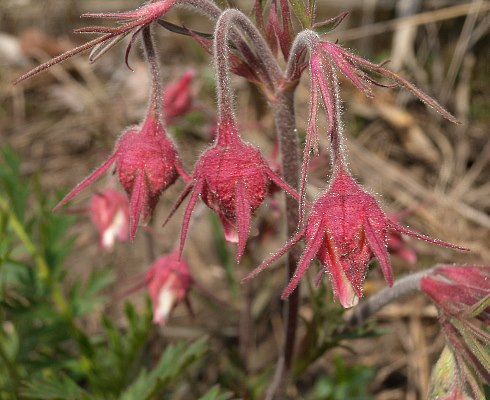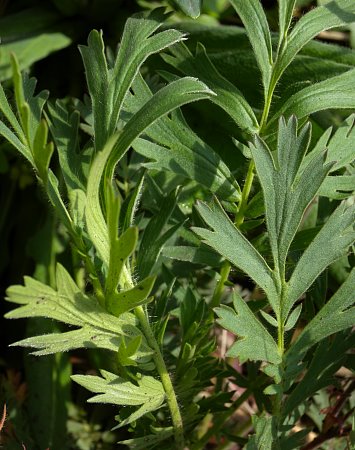
Individual leaflets are oblanceolate in shape, shallowly cleft, coarsely dentate, and slightly ciliate along their margins; they are somewhat variable and irregular. During the growing season, the upper leaf surface is medium green and sparsely covered with short appressed hairs, while the lower leaf surface is light green and hairy primarily along the rachis and major veins. Flowering stalks develop from the center of the rosette, becoming 5-10" tall at maturity. Each stalk terminates in an umbel of 3 nodding flowers. The flowering stalks (peduncles) are reddish green to reddish purple, terete, and densely hairy. There is a pair of leafy bracts at the base of each umbel that are deeply cleft with linear to linear-oblong segments. These bracts are reddish green to reddish purple and hairy. Sometimes pairs of leafy bractlets develop along the hairy pedicels of the flowers; these bractlets are also deeply cleft with linear segments. Individual
Cultivation: The preference is full sun, mesic to dry conditions, and a barren soil that is rocky, gravelly, or sandy. Young plants should be kept well-watered during hot summer weather as Prairie Smoke is adapted to a somewhat cool northern climate. Competition from taller and more aggressive plants is not tolerated.
Range & Habitat: The native Prairie Smoke is restricted to northern Illinois, where it is uncommon. Elsewhere in the state, it is absent. In Illinois, habitats consist of dry gravelly prairies and hill prairies. In other states (e.g., Michigan), this plant has been found in sand prairies and alvars (a habitat that is dominated by limestone slabs). This conservative species is found in high quality prairies where the vegetation is neither too dense nor tall.
Faunal Associations: The flowers are cross-pollinated by bumblebees, which seek primarily nectar from the flowers (personal observation, 2011; Choberka et al., 2000). These insects are strong enough to force their way into the flowers. The adults of a leaf beetle, Graphops marcassita, have been observed to feed on Prairie Smoke (Clark et al., 2004). The larvae of this beetle may also feed on the roots.
Photographic Location: The wildflower garden of the webmaster in Urbana, Illinois.

Comments: Prairie Smoke is an attractive little plant that should be cultivated more often. The reddish flowers remain attractive for 2-3 months during both the blooming period and afterwards as the achenes develop. It is an easy plant to identify because no other Geum sp. (Avens) within Illinois develops achenes with long feathery tails. Only one other species in this genus, Geum rivale (Water Avens), also produces large reddish flowers. However, Water Avens prefers much wetter habitats than Prairie Smoke. Within the state, other species in this genus produce more conventional flowers with 5 spreading petals that are white or yellow.